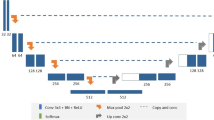Abstract
In the planning and quantitative assessment of brain tumor treatment, determining the tumor extent is a major challenge. Non-invasive magnetic resonance imaging (MRI) has developed as a diagnostic technique for brain malignancies without the use of ionizing radiation. Gliomas (tumors) are the most common and severe kind of brain tumor due to their infiltrative nature and rapid growth. Identifying tumor boundaries from healthy cells in the clinical environment is still a challenging task. The fluid-attenuated inversion recovery (FLAIR) MRI method can provide clinicians with information on tumor infiltration. Many recommendations include using deep neural networks (DNN) in image segmentation because they perform well in automated brain tumor image segmentation. Due to the complexity of the gradient diffusion problem, training a deeper neural network requires a lot of time and a lot of computing resources. As a result, utilizing fluid-attenuated inversion recovery (FLAIR) MRI data, this project compares two deep learning architectures, U-Net, ResNet, AlexNet, VGG16-Net, and V-Net, for totally automated brain lesion diagnosis and segmentation. In contrast to traditional supervised machine learning techniques, these deep learning-based algorithms do not rely on natural features, and instead, construct a pyramid increasingly complex characteristics are drawn directly from the data.
Access this chapter
Tax calculation will be finalised at checkout
Purchases are for personal use only
Similar content being viewed by others
References
Lateef, F., Ruichek, Y.: Survey on semantic segmentation using deep learning techniques. Neurocomputing 338, 321–348 (2019)
Long, J., Shelhamer, E., Darrell, T.: Fully convolutional networks for semantic segmentation. In: IEEE Conference on Computer Vision and Pattern Recognition (CVPR), pp. 3431–3440 (2015)
Ronneberger, O., Fischer, P., Brox, T.: U-Net: convolutional networks for biomedical image segmentation. In: Medical Image Computing and Computer-Assisted Intervention, pp. 234–241 (2015)
Krizhevsky, A., Sutskever, I., Hinton, G.E.: ImageNet classification with deep convolutional neural networks. In: Advances in Neural Information Processing Systems, pp. 1097–1105 (2012)
Milletari, F., Navab, N., Ahmadi, S.A.: V-net: fully convolutional neural networks for volumetric medical image segmentation. In: 2016 Fourth International Conference on 3D Vision, IEEE, pp. 565–571 (2016)
Badrinarayanan, V., Kendall, A., Cipolla, R.: SegNet: a deep convolutional encoder-decoder architecture for image segmentation. IEEE Trans Pattern Anal Machine Intell 39(12), 2481–2495 (2017)
Zhao, H., Shi, J., Qi, X., Wang, X., Jia, J.: Pyramid scene parsing network. In: Proceedings of the IEEE Conference on Computer Vision and Pattern Recognition, pp. 2881–2890 (2017)
Too, E.C., Yujian, L., Njuki, S., Yingchun, L.: A comparative study of fine-tuning deep learning models for plant disease identification. Comput. Electron. Agric. 161, 272–279 (2018)
Sergey Ioffe, C.S.: Batch normalization: accelerating deep network training by reducing internal covariate shift. In: International Conference on Machine Learning ICML, pp. 448–456 (2015)
Pereira, S., Pinto, A.: Brain tumor segmentation using convolution neural networks in MRI images. IEEE Trans. Med. Imaging 1240–1251 (2015)
Lang, R., Zhao, L.: Brain tumor image segmentation based on convolution neural network. In: International Congress on Image and Signal Processing Biomedical Engineering and Informatics, pp. 1402–1406 (2016)
Isensee, F., Kickingereder, P., Wick, W., Bendszus, M., Maier-Hein, K.H.: Brain tumor segmentation and radiomics survival prediction. In: Brats 2017 Challenge International MICCAI Brainlesion Workshop, pp. 287–297. Springer (2017)
Hesamian, M.H., Jia, W., He, X., Kennedy, P.: Deep learning techniques for medical image segmentation. J. Digit. Imaging 32, 582–596 (2019)
Altaf, F., Islam, S.M.S., Akhtar, N., Nanjua, N.K.: Going deep in medical image analysis: concepts, methods, challenges, and future directions. IEEE Access 7, 99540–99572 (2019)
Ma, Z., Tavares, J.M.R.S., Jorge, R.M.N.: A review on the current segmentation algorithms for medical images. In: International Conference on Imaging Theory and Applications (2009)
Yu-Qian, Z., Wei-Hua, G., Zhen-Cheng, C., Tang, J.-T., Li, L.-Y.: Medical images edge detection based on mathematical morphology. IEEE Eng. Med. Biol. 6492–6495 (2006)
Shen, D., Wu, G., Suk, H.I.: Deep learning in medical image analysis. Annu. Rev. Biomed. Eng. 19, 221–248 (2017)
He, K., Zhang, X., Ren, S., Sun, J.: Deep residual learning for image recognition. In: Proceedings of the IEEE Conference on Computer Vision and Pattern Recognition, pp. 770–778 (2016)
Author information
Authors and Affiliations
Corresponding author
Editor information
Editors and Affiliations
Rights and permissions
Copyright information
© 2022 The Author(s), under exclusive license to Springer Nature Singapore Pte Ltd.
About this paper
Cite this paper
Chatterjee, P., Sahoo, S., Kar, S., Biswal, P. (2022). Comparative Study of Medical Image Segmentation Using Deep Learning Model. In: Dehuri, S., Prasad Mishra, B.S., Mallick, P.K., Cho, SB. (eds) Biologically Inspired Techniques in Many Criteria Decision Making. Smart Innovation, Systems and Technologies, vol 271. Springer, Singapore. https://doi.org/10.1007/978-981-16-8739-6_27
Download citation
DOI: https://doi.org/10.1007/978-981-16-8739-6_27
Published:
Publisher Name: Springer, Singapore
Print ISBN: 978-981-16-8738-9
Online ISBN: 978-981-16-8739-6
eBook Packages: Intelligent Technologies and RoboticsIntelligent Technologies and Robotics (R0)




